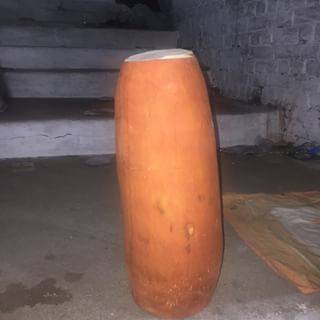
My encounter with Ram Kand Mool is quite accidental. I saw it at Dharward. I went to Dharward Agricultural University on September 22,2017, along with Mr.M.C.Dominic, Managing Editor of Krishi Jagran, to attend the Agriculture Fair organized by the University. When we were moving around the campus, watching the exhibits, we saw a small crowd near the main gate of the campus. We became curious to know what was happening there. When we along with Mr.Thippe Swamy, our Dharward District Coordinator took a place among the crowd.We saw a man in an old tracksuit and T –shirt sitting behind a drum. We astonished to find that it was not a real drum, but an edible tuber that he was selling to the people who were anxiously waiting for their turn. It was very interesting to see that with his sharp knife he was cutting skin thin slices with utmost care and selling three pieces for rupees ten. The tuber is brown in colour and its flesh is light brown. Only 1/10th of the portion was sold that time , but he had a reasonably good collection in his box. He was enjoying the sales and loudly announcing that it is Ram kand mool, that was the health food of Rama, Lakashmana and Sita during their exile (vanvasa).

We also decided to taste it and Thippe Swamy paid for that. We tasted it to feel the sweet, cool piece that remembered me a taste familiar to the sap of coconut wood that oozes out when we cut the matured tree. The size of the tuber, its taste and unknown nature made me to inquire further. The result was very interesting. It’s a very rare , impressive delicious root rarely available in the hills of Sree sailam and in Chitrakoot and Kamadgiri Parvat. It is reported that the drum like root with brown thin skin and fleshy inside is nutritive, thirst fulfilling and good to health.
There is a legend that when Lord Ram was exiled to forests along with his wife Sita and brother Lakshman, the royal family used to live under a thatch roof and used to feed on kandmool. A few of my friends said ,very often, street vendors around places of pilgrimage, were seen selling the so-called Ramakand or Rama chandra kandmool. The source of this huge root-fruit is the best-kept secret by the vendors. Scientific examination of this food-item has revealed it to actually be a part of the Agave plant.
In 1980's, the botanists of India, try to find out more information on this large, cylinder-shaped, brownish tuber. It was a challenge for them. They asked public help to identify this huge roots. But all their efforts went into vain. About 10 years ago, the University of Kolhapur resorted to DNA fingerprinting to identify this plant and came up with the conclusion that it is a variety of Agave americana. Agave americana is one of the several agaves used for distillation. After fermentation, it produces the drink called Pulque. In the tequila-producing regions of Mexico, this type of agaves called Mezcales. The high-alcohol product of agave distillation is called Mezcal.
The anatomical study shows the plant is a typical monocotyledonous vascular bundle arrangement. But this only added to the confusion, as monocots have adventitious roots and not a tap root system. Therefore to find out the source, the plant material was obtained from one of the vendors from Jyothiba hill temple at Wadi Ratnagiri, Kolhapur District, Maharashtra. Slices of approximately 4.5 inches radius and 2–3 mm breadth were purchased and brought to the laboratory. DNA was extracted from these slices using the protocol described by Doyle and Doyle and its purity was checked on agarose gel. For identification of the plant species, the plastid locus for maturasek(matk) was selected. The plastid and mitochondrial DNA have been viewed as the most appropriate regions to sequence for species identification in plants and animals respectively . The similarity search showed 89% identity with the partial sequence of the plastid locus maturase of Agave sisalana.
Further to confirm the identification, plants of Agave were visited and their leaves enclosing the rosette and juvenile inflorescence were excised, which exposed the core of the rosette. This core is soft and of similar dimension to that of the Ramkand being sold . Even though the source of obtained plant material was identified as A. sisalana on the basis of percentage of identity, it is possible that other species of Agave are also being processed and used for the same purpose. It is obvious that there are several factors in the identification of a species, but getting the field of possibilities narrowed to this extent can also help in identification of such cryptic plants. Ram Kand Mool is a research material for our agriculture scientists and has to find out what are the nutrients and medicines hiding in it.















